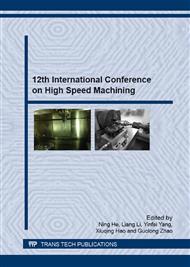p.326
p.333
p.340
p.348
p.359
p.369
p.374
p.381
p.387
Optimal Design Analysis of the Thickness of Shrink-Fit Holder
Abstract:
A calculation scheme to gain the relationship between the thickness of shrink-fit holder and thermodynamic properties. Based on the theoretical analysis of fitting molder between shrink-fit holder and tool, then the thermodynamic properties of the shrink-fit holder and cutting tool such as contact pressure, equivalent stress and deformation are analyzed at different thickness of shrink-fit holder in static, under cutting force and inducting heating by using the finite element software ANSYS. The results show that the total contact pressure and maximum equivalent stress increased and the minimum thermal displacement difference decreased with the increase of holder thickness. Under the action of cutting force, the contact stress on the tool holder no longer uniformed and the maximum contact stress significantly increased, cutting tool also deformed. Finally a method to determine the reasonable holder thickness is given and it has a practical guiding significance for the design and selection of the shrink-fit tool holder.
Info:
Periodical:
Pages:
359-366
Citation:
Online since:
January 2016
Authors:
Keywords:
Price:
Сopyright:
© 2016 Trans Tech Publications Ltd. All Rights Reserved
Share:
Citation:


